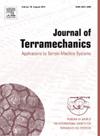Mesomechanical analyses on the failure mechanism of the snow cluster assembly under direct shear test using discrete element method
IF 3.7
3区 工程技术
Q3 ENGINEERING, ENVIRONMENTAL
引用次数: 0
Abstract
The shear strength of snow is an important parameter for assessing the safety of polar snow projects. To investigate the bearing and failure mechanisms of compacted snow during shear, a series of direct shear tests and corresponding discrete element simulations were conducted. The discrete element model was established using the “falling snow method” to simulate snowflake generation, landing, compression, and sintering. The contact model parameters were determined based on tested data, and simulated strengths under direct shear matched the experimental results. Results indicate that snow with a density below 450 kg·m−3 primarily fails through bending, while those at or above this density mainly fail by shearing. As density and normal stress increase and sintering decreases, the percentage of bond shear failures increases, while bond bending failures decrease. The contribution of bond contact force to shear stress was greater than that of frictional contact force, with normal contact force contributing more than tangential contact force. At shear’s end, the bond contact force contribution in high-density snow was 66.9 %, lower than the 85.3 % in low-density snow. Additionally, tensile zone breakage consistently exceeded that in the compressive zone.
用离散元法对雪簇组合体直剪破坏机理进行细观力学分析
雪的抗剪强度是评价极地造雪工程安全性的重要参数。为研究压实雪在剪切过程中的承载和破坏机制,进行了一系列直剪试验和离散元模拟。采用“落雪法”建立离散元模型,模拟雪花的产生、降落、压缩和烧结过程。根据试验数据确定了接触模型参数,模拟的直剪强度与试验结果吻合。结果表明,密度在450 kg·m−3以下的雪主要通过弯曲破坏,而密度在450 kg·m−3以上的雪主要通过剪切破坏。随着密度和法向应力的增大,烧结程度的降低,粘结体剪切破坏的比例增加,而粘结体弯曲破坏的比例减少。粘结接触力对剪切应力的贡献大于摩擦接触力,法向接触力的贡献大于切向接触力。在剪切端,高密度雪的粘结接触力贡献为66.9%,低于低密度雪的85.3%。此外,拉伸区破坏始终大于压缩区破坏。
本文章由计算机程序翻译,如有差异,请以英文原文为准。
求助全文
约1分钟内获得全文
求助全文
来源期刊

Journal of Terramechanics
工程技术-工程:环境
CiteScore
5.90
自引率
8.30%
发文量
33
审稿时长
15.3 weeks
期刊介绍:
The Journal of Terramechanics is primarily devoted to scientific articles concerned with research, design, and equipment utilization in the field of terramechanics.
The Journal of Terramechanics is the leading international journal serving the multidisciplinary global off-road vehicle and soil working machinery industries, and related user community, governmental agencies and universities.
The Journal of Terramechanics provides a forum for those involved in research, development, design, innovation, testing, application and utilization of off-road vehicles and soil working machinery, and their sub-systems and components. The Journal presents a cross-section of technical papers, reviews, comments and discussions, and serves as a medium for recording recent progress in the field.
 求助内容:
求助内容: 应助结果提醒方式:
应助结果提醒方式:


